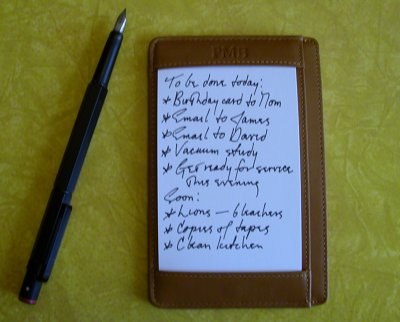
In first grade they taught us to print. Then in second grade they taught us cursive handwriting. I caught on, though from the start my handwriting was messy. Also I didn't much care for all the loops and whirls in the standard style of handwriting we learned in school. Writing all those loop-de-loops drove me crazy.
So, starting in fifth grade, I began experimenting. Designing my own style of handwriting. Lose those loops. Try out different styles of letters and ligatures. It took me a while, and then it took me a while longer to become adept at writing in a strange new way. But by the time I was in seventh grade or so, I was very much at ease with writing in a self-designed style which bore little resemblance to any cursive mode taught in school.
A handwriting of my own. It mutated over the years. For a time in my teens, very messy. Here and there, a letter changed: I can still remember the day, late August or early September of 1982, when I changed the way I wrote capital L.
What emerged by age 20 or so was a style of handwriting that looks something like the chrome lettering you see on automobiles. Still somewhat messy, what do you expect from a lefty? Two different ways of writing small f, depending on context. Two different styles of small x. At least five or six radically different ways of writing small t. "O" in "of" written unlike "o" in any other word, clockwise instead of counterclockwise.
I see other peoples' handwriting, sometimes they depart more or less from school-taught handwriting. But rarely do I see anyone who has departed as far, or as deliberately, as I. Part and parcel of living in a self-designed world of my own.
Oddly enough, I continued to use the old school-taught writing alongside my own style of handwriting, on into my mid 20s at least. Often wrote in the school-taught way when I was writing school assignments, or sometimes for others to read. But it's been years, and I doubt I'm fluent in the school-taught handwriting any longer. It's my own style of handwriting or nothing nowadays. When I'm not using the keyboard, which has become ubiquitous in the lives of many of us as never we once would have dreamed.
For some years I wrote my script "e" the way you do. I've done the script capital "L" that way. From a friend I picked up a angularized script capital "F" that basically looks like a backward print capital "F" with a bit of flair. And similar to the number "7" with a horizontal stroke through the middle.
ReplyDeleteHere's one: how do you do your script small "x"? I do it similarly to as if I were doing the standard script small e but lifting my pen from the page during the upper part of the loop.
Later I developed my -- umm -- expanded alphabet for -- umm -- spelling reform, the idea being to make English predictably pronounceable from the spelling, without making old text unreadable to those who know only the new system. And I developed script forms for all that, too. Well, it was a hobby.
Also, I wanted to preserve the spelling differences of differently spelt homonyms! of which I made a collection which I wish that I had preserved.
ReplyDeleteI still remember:
The bard heard the barred herd.
I do the script small x in two strokes, the first running diagonally downward from upper left to lower right and continuing on from any preceding "connectible" character; the second stroke running diagonally upward from lower left to upper right and continuing on from the upper right to any following "connectible" character.
ReplyDelete(In my handwriting, some letters are "connectible" with preceding or following letters in the same word, and others are not.)
However, at the end of a word I do the script small x differently, in three connected strokes, first a stroke from upper left to lower right, then continuing on more or less upward with a stroke from lower right to upper right, and then continuing back downward again with a stroke from upper right to lower left— almost like a squashed-together "fish."
And my script capital X, as in Xenophon or Xerxes, is a sight to behold. First a stroke like a backwards "C" to form the upper and lower left parts of the X. Then a stroke like a forwards "C" to form the upper and lower right parts of the X. Then a third horizontal stroke through the center of the X, and joined on to any following connectible character.
Wow, a real x-man!
ReplyDeleteYour script capital X is a good solution for a problem which bothered me, I never solved it. The Russian capital script X is the backward C against forward C, and I thought it looked really cool, but I found it hard to use for English because people thought it looked like a capital C with something leaning against it. But the way you do it solves the problem! Congratulations!
You have lovely handwriting! :)
ReplyDeleteI experimented with my cursive writing too, starting in high school, but eventually I dropped it for everything except my signature; now I print. I also type using basically my two index fingers and staring at the keyboard, but as with the longhand printing practice has made it a fairly rapid process.
ReplyDeleteSince the only cursive I use is in my signature, the only innovation I still use is the capital G in my surname, which is basically an oversized lower-case G. The lyre-shaped capital G taught in school, and used by both my parents, just never made sense to me.
The downside to my decision not to use cursive otherwise is, if I ever went into the witness protection program with a new identity, I'd be toast.